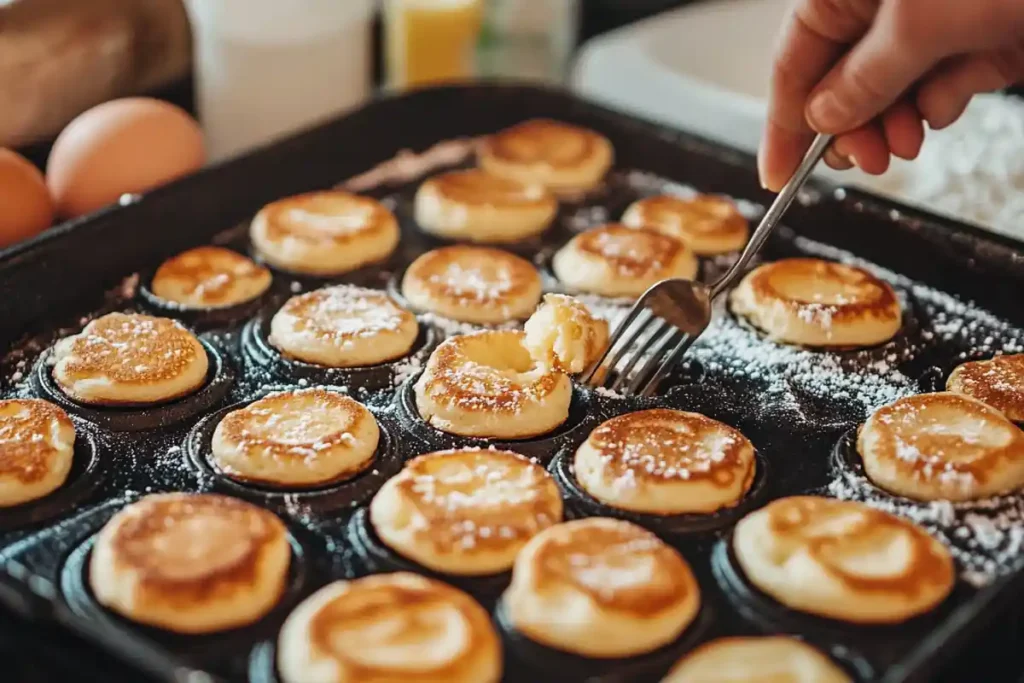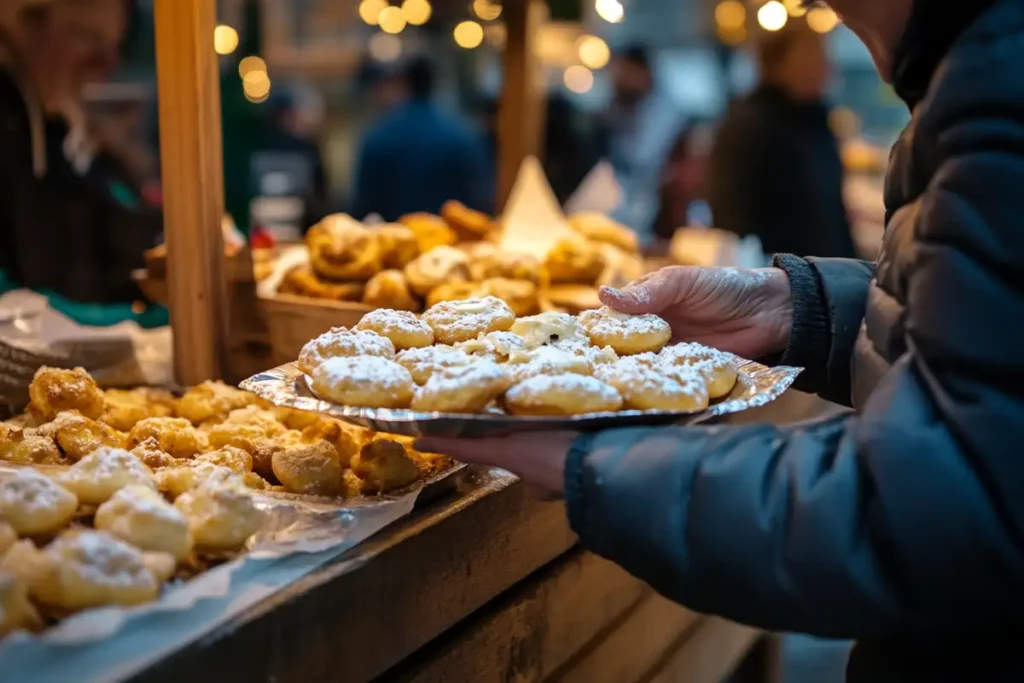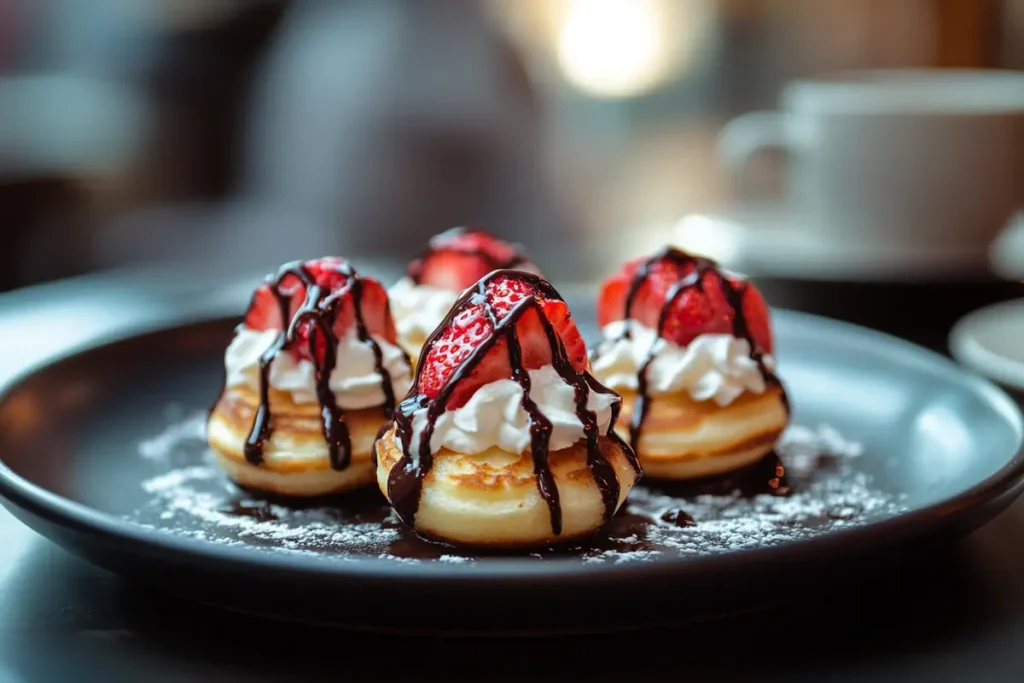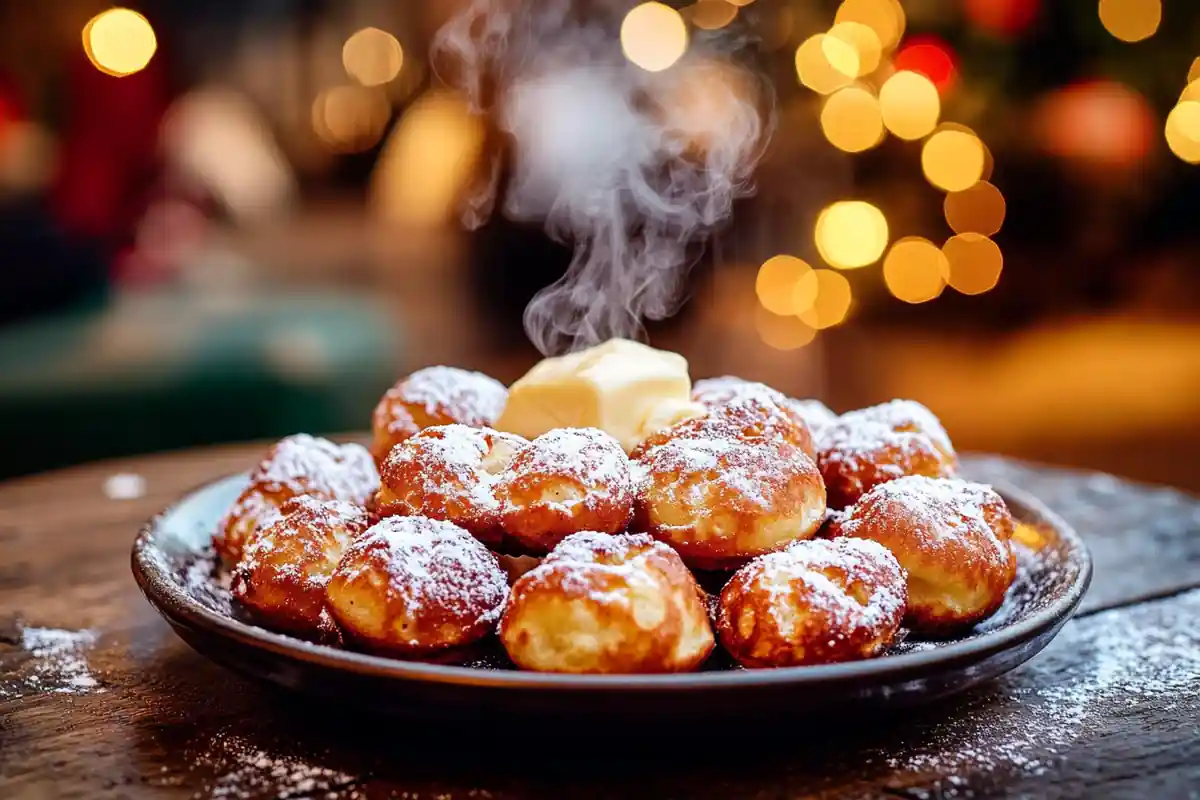What is poffertjes in English? If you’ve ever strolled through the lively streets of a Dutch market, you’ve likely caught the tantalizing aroma of poffertjes. These tiny, fluffy treats are more than just a culinary delight—they’re a beloved part of Dutch culture. But what exactly are poffertjes, and how do they translate into English? In this article, we’ll explore their history, cultural significance, recipe secrets, and much more. So, get ready to uncover the magic behind these bite-sized Dutch pancakes.
1: Introduction to Poffertjes
What Are Poffertjes?
Poffertjes (pronounced poh-fur-chuhs) are delightful mini pancakes that hail from the Netherlands. Unlike the classic flat pancakes you might be familiar with, these tiny delights are round, puffed up, and irresistibly fluffy. Traditionally, they’re made with a yeast-based batter, giving them a light and airy texture. Served piping hot with a dollop of butter and a generous dusting of powdered sugar, poffertjes are the epitome of comfort food.
These treats are often enjoyed at markets, fairs, and festivals, where their nostalgic aroma fills the air. Whether served on a cold winter evening or as a midday snack, they’ve become a staple in Dutch culinary traditions.
Why Are Poffertjes Special?
What makes poffertjes so unique is their texture and flavor. Thanks to the use of buckwheat flour and yeast, they boast a slightly nutty flavor with a tangy undertone that sets them apart from traditional pancakes. Their small size and fluffy interior make them incredibly versatile—they can be sweet, savory, or somewhere in between!
In Dutch culture, they symbolize togetherness and celebration. Families often gather to enjoy them during holidays, and they’re a must-try for anyone exploring Dutch cuisine.
Literal Translation of Poffertjes in English
The name “poffertjes” roughly translates to “little puffs” in English, aptly describing their airy texture and charming appearance. While they’re often referred to as mini Dutch pancakes, this description barely scratches the surface of their cultural and culinary significance. The term itself comes from the Dutch word “poffen,” which means “to puff,” reflecting how the batter puffs up as it cooks.
2: History and Origins of Poffertjes

The Origins of Poffertjes
Poffertjes trace their roots back to the Netherlands in the 18th century, originating as a humble treat among the working class. They were initially made with simple, inexpensive ingredients, such as buckwheat flour and yeast, which were readily available. Over time, these tiny, puffy pancakes gained popularity, thanks to their delightful flavor and unique texture. In fact, the word “poffertjes” comes from the Dutch verb “poffen,” meaning “to puff,” which perfectly describes their airy and light nature.
Interestingly, some historians believe that poffertjes were influenced by French culinary traditions, possibly derived from crêpes. However, the Dutch adapted the recipe to include yeast and a specialized pan, giving them their distinct identity.
Evolution Through the Centuries
Initially linked to religious festivals and fairs, poffertjes were often served during special church events. They became a symbol of community and celebration, often distributed to worshippers and pilgrims as a comforting snack. By the 19th century, they transitioned from a religious treat to a staple at Dutch markets and street fairs, becoming a beloved street food.
Today, poffertjes have evolved far beyond their humble beginnings, delighting locals and tourists alike at festive events, winter markets, and even gourmet restaurants. Their global popularity showcases their enduring charm and culinary appeal.
Poffertjes in Dutch Cultural Traditions
In Dutch culture, poffertjes are more than just food; they are an experience. They evoke a sense of nostalgia, especially during winter when they’re served warm and paired with hot beverages. From festive Christmas markets to summer fairs, poffertjes play a central role in bringing people together. Families often make them at home for special occasions, strengthening the tradition across generations.
3: Characteristics of Poffertjes
Appearance and Shape
Poffertjes are small, round, and golden brown, with a slightly shiny surface from the butter they’re typically served with. Their unique puffed-up appearance is achieved using a special poffertjes pan with shallow indentations, ensuring they cook evenly into their signature shape. Each bite-sized piece is a feast for the eyes as much as the taste buds.
Flavor and Texture Profile
What truly sets poffertjes apart from other mini pancakes is their texture. They are soft and fluffy on the inside, with a subtle chewiness that makes them so satisfying. The use of buckwheat flour adds a mild, nutty flavor, while the yeast lends a slight tang, balancing perfectly with the sweetness of powdered sugar or syrup toppings.
When served fresh, poffertjes have a delightful melt-in-your-mouth quality, making them utterly irresistible.
Key Ingredients in Traditional Poffertjes
Traditional poffertjes use a straightforward yet unique blend of ingredients:
- Buckwheat flour for its nutty flavor and dense texture.
- Yeast to help the batter rise and create the iconic puffed shape.
- Milk and eggs for richness and binding.
- A touch of sugar and salt to balance flavors.
The combination of these ingredients creates the perfect balance of lightness, sweetness, and subtle nuttiness, making poffertjes a standout dish.
4: How to Make Poffertjes at Home

Essential Ingredients and Equipment
Creating authentic poffertjes at home is easier than you think, especially with the right ingredients and tools. To make about 40 pieces, you’ll need:
- Buckwheat flour (¾ cup)
- All-purpose flour (¾ cup)
- Active dry yeast (1 packet or 7g)
- Milk (1 cup, lukewarm)
- Eggs (1 large)
- Butter (for greasing and topping)
- Powdered sugar (for garnish)
For equipment, a poffertjes pan is ideal. It has shallow indentations that ensure the batter cooks into its signature puffed shape. If you don’t have one, a mini muffin tin can work as an alternative, though the results may vary.
Step-by-Step Recipe
- Activate the Yeast
In a small bowl, mix warm milk with a teaspoon of sugar and the yeast. Let it rest for about 10 minutes until frothy. - Mix Dry Ingredients
In a large mixing bowl, whisk together the buckwheat flour, all-purpose flour, and a pinch of salt. - Combine Wet Ingredients
Beat the egg in a separate bowl and add it to the yeast mixture. Gradually pour this into the dry ingredients while whisking, ensuring a smooth, lump-free batter. - Rest the Batter
Cover the batter and let it sit in a warm place for 30–60 minutes. This allows the yeast to activate, creating a light and airy texture. - Prepare the Poffertjes Pan
Heat your pan over medium heat and lightly grease each cavity with butter. - Cook the Poffertjes
Pour small amounts of batter into each cavity. Cook until bubbles appear and the edges start to set. Flip them using a skewer or fork, cooking until golden on both sides. - Serve Hot
Transfer to a plate, top with butter, and dust generously with powdered sugar.
Common Mistakes to Avoid
- Skipping the resting time: Resting the batter ensures the poffertjes are fluffy and flavorful. Don’t skip this step.
- Overheating the pan: A pan that’s too hot can burn the poffertjes, leaving the inside undercooked.
- Overfilling the cavities: Avoid overfilling to maintain the classic puffed shape.
Pro Tip: For more breakfast inspiration, check out the mini pancake guide on Successfully Recipes.
5: Variations of Poffertjes
Gluten-Free and Vegan Variations
Poffertjes are wonderfully versatile, and there are options to suit different dietary needs. For a gluten-free version, replace the all-purpose flour with a gluten-free blend. Since buckwheat flour is naturally gluten-free, it works perfectly as a base.
For a vegan alternative, swap milk for almond or oat milk, and use a flaxseed meal or applesauce as an egg substitute. The results are just as delicious and fluffy!
Modern Toppings and Accompaniments

While the classic toppings of butter and powdered sugar remain timeless, modern variations offer exciting flavors. Popular options include:
- Fresh fruits: Strawberries, bananas, or blueberries add a refreshing touch.
- Chocolate drizzle or Nutella: Perfect for those with a sweet tooth.
- Whipped cream: A dollop of cream elevates the indulgence.
For a savory twist, experiment with toppings like cheese, herbs, or even smoked salmon.
Savory Poffertjes Options
Though traditionally sweet, savory poffertjes are gaining popularity. By reducing the sugar in the batter and adding ingredients like Parmesan, herbs, or spices, you can create a delightful appetizer. These are best served with sour cream or a tangy dipping sauce.
6: Poffertjes vs. Other Mini Pancakes
Comparison with Traditional Pancakes
At first glance, poffertjes might resemble pancakes, but the differences are striking upon closer inspection. Traditional pancakes, whether American-style or crepes, are typically larger and flatter, with a denser texture. In contrast, poffertjes are small, puffed, and airy, thanks to their yeast-based batter.
Another key distinction lies in the ingredients. While pancakes often rely on baking powder for leavening, poffertjes use yeast and buckwheat flour, which lend them a unique nutty flavor and slightly tangy taste. Their preparation also sets them apart—pancakes are cooked on a flat griddle, while poffertjes require a special pan to achieve their round, puffed shape.
When answering the question What is poffertjes in English?, it’s helpful to describe them as “mini Dutch pancakes,” but their texture and preparation elevate them beyond what most people associate with typical pancakes.
Differences Between Poffertjes and Æbleskiver
Another mini pancake that often draws comparisons to poffertjes is the Danish æbleskiver. While both are round and cooked in specialized pans, they differ significantly in texture and flavor.
- Shape and Texture: Æbleskiver are usually more spherical and have a denser interior, often containing fillings like apple slices or jam, whereas poffertjes remain fluffy and unfilled.
- Batter Composition: Æbleskiver use a richer batter with more eggs, sometimes even cream, resulting in a different taste profile.
- Serving Style: Poffertjes are served plain with toppings, while æbleskiver often come with powdered sugar and fruit preserves on the side.
These differences highlight the diverse culinary traditions of Northern Europe, where small, intricate pancakes hold a special place.
Similarities to Other International Dishes
Globally, poffertjes have parallels with dishes like Japanese dorayaki, Indian appam, and Russian oladi. Each of these dishes shares a love for small, round pancakes, yet each stands apart due to unique ingredients or cooking methods:
- Dorayaki: Sweet and filled with red bean paste.
- Appam: Savory with rice-based batter, served with curries.
- Oladi: Fluffy and tangy, often served with sour cream or jam.
Despite these global variations, poffertjes remain uniquely Dutch, celebrated for their simplicity and unmistakable puffed texture.
7: Cultural Significance of Poffertjes
Role in Dutch Festivals and Holidays
In the Netherlands, What is poffertjes in English? is a question often answered during festive seasons. These tiny, fluffy pancakes are more than just food—they’re a cherished tradition. During winter holidays, especially Christmas, their warm, buttery aroma fills the air at markets and fairs. Vendors skillfully prepare them fresh on large cast-iron pans, delighting crowds with their golden-brown perfection.
Poffertjes have long been a symbol of togetherness. Families gather during celebrations to share plates piled high with these sweet treats, topped with butter and powdered sugar. Their presence at festivals and fairs fosters a communal spirit, drawing people closer through the joy of this comforting dish.
Understanding What is poffertjes in English? means appreciating their cultural significance. They are more than just “mini Dutch pancakes”; they represent the warmth and hospitality of Dutch traditions. Whether enjoyed during a bustling market or at home with loved ones, poffertjes remain an essential part of Dutch celebrations.
Poffertjes as a Culinary Symbol
Beyond their role in festivals, poffertjes have become a culinary ambassador for Dutch culture. Their simple ingredients and unique preparation make them an accessible dish for anyone exploring international cuisine. Tourists visiting Amsterdam often seek out poffertjes as a quintessential Dutch experience, much like stroopwafels or herring.
Interestingly, the question What is poffertjes in English? often arises among visitors, reflecting their growing global recognition. Describing them as “little puffs” or “mini Dutch pancakes” helps bridge the cultural gap, while their rich history and irresistible flavor speak for themselves.
Modern Interpretations of Poffertjes
While the traditional recipe remains a favorite, modern chefs have embraced creative twists on poffertjes. Gourmet toppings like salted caramel, mascarpone, or edible flowers add sophistication, while savory versions bring new life to this classic dish. Their versatility ensures that poffertjes continue to delight new generations of food lovers.
8: Nutritional Information of Poffertjes
Caloric and Macronutrient Breakdown
Though poffertjes are a treat, understanding their nutritional content helps balance indulgence with mindfulness. A typical serving of 10–12 poffertjes, topped with butter and powdered sugar, contains approximately:
- Calories: 250–300
- Carbohydrates: 40–45 grams
- Protein: 5–7 grams
- Fat: 8–10 grams
The use of buckwheat flour provides a small boost in fiber and micronutrients, making poffertjes a slightly more nutritious option compared to traditional white flour-based pancakes. However, toppings like butter and powdered sugar contribute to the overall calorie count.
Health Considerations and Modifications
For those wondering, What is poffertjes in English?—a beloved “little puff”—their small size makes portion control manageable. However, like any sweet treat, they’re best enjoyed in moderation. To make them more diet-friendly, consider:
- Reducing sugar: Use fresh fruits like berries or apples instead of powdered sugar for natural sweetness.
- Switching fats: Replace butter with plant-based alternatives or use a non-stick spray to reduce fat content.
- Increasing protein: Add protein powder to the batter or serve with Greek yogurt for a more balanced dish.
Understanding the nutritional breakdown ensures you can savor poffertjes while staying mindful of your health goals.
9: Where to Find Poffertjes
Poffertjes in the Netherlands
If you’re visiting the Netherlands, finding authentic poffertjes is a must. These delightful treats are a staple at:
- Street markets and fairs: Locations like Amsterdam’s Albert Cuyp Market or Rotterdam’s Markthal are famous for serving fresh, piping-hot poffertjes.
- Cafes and restaurants: Many Dutch eateries feature poffertjes on their dessert menus, often pairing them with unique toppings.
- Supermarkets: For a convenient option, Dutch supermarkets sell pre-made poffertjes that can be reheated at home.
International Availability of Poffertjes
Thanks to their growing popularity, poffertjes are no longer confined to the Netherlands. Internationally, you can find them at:
- Food festivals and pop-up stalls: These events often showcase Dutch cuisine, making poffertjes a star attraction.
- Dutch-themed cafes and bakeries: Many cities now have specialty shops that feature poffertjes alongside other Dutch delights.
- Online retailers: Purchase pre-made poffertjes, mix kits, or specialized pans to recreate the experience at home.
Online Retailers and DIY Options
For those who can’t find poffertjes locally, online shopping offers plenty of options. Retailers sell everything from ready-to-eat versions to DIY kits with all the necessary ingredients. Investing in a poffertjes pan ensures you can perfect the recipe at home and enjoy this Dutch classic whenever the craving strikes.
Pro Tip: Explore related recipes and techniques on Successfully Recipes, such as their guide to mini pancakes, for more inspiration in the kitchen.
10: Frequently Asked Questions
If you’ve been wondering, What is poffertjes in English?, they’re often referred to as ‘little puffs’ or ‘mini Dutch pancakes’—a fitting description for their airy texture.
What is the English Translation of Poffertjes?
The question What is poffertjes in English? is a common one among those discovering this Dutch delicacy. The term “poffertjes” roughly translates to “little puffs” in English, describing their small, fluffy, and airy appearance. While often referred to as mini Dutch pancakes, this translation doesn’t fully capture their unique texture and cultural significance.
How Do Poffertjes Differ From Regular Pancakes?
Poffertjes are quite different from traditional pancakes in several ways. Regular pancakes are typically larger, flatter, and use baking powder for leavening. In contrast, poffertjes are much smaller, puffed, and made with a yeast-based batter that includes buckwheat flour, giving them a nutty flavor and a softer, chewier texture. Unlike pancakes, which are cooked on a flat griddle, poffertjes are cooked in a special pan with shallow cavities to achieve their iconic shape.
Can Poffertjes Be Made Without a Special Pan?
If you’ve been exploring What is poffertjes in English?, you might wonder if you need a special pan to make these delightful Dutch mini pancakes. While a poffertjes pan is ideal for creating their signature puffed shape, it’s not the only option. You can use a mini muffin tin as an alternative. However, the texture and appearance may differ slightly from traditional poffertjes.
For the best and most authentic results, investing in a poffertjes pan is highly recommended. This specialized tool ensures even cooking and achieves the classic light, fluffy texture that makes poffertjes so unique. Whether you use a proper pan or a creative alternative, these “little puffs” are always a treat to make and enjoy.
What Are Traditional Toppings for Poffertjes?
Traditional toppings for poffertjes are simple yet delicious. The most common pairing is a generous pat of butter and a dusting of powdered sugar. Other popular options include:
- Syrup or honey: Adds a rich sweetness.
- Fresh fruits: Strawberries or blueberries offer a refreshing twist.
- Whipped cream: Perfect for those who enjoy an indulgent touch.
These classic and modern toppings enhance the natural flavors of poffertjes, making them a versatile treat for all tastes.
Would you like me to assist with wrapping up the article or exploring additional related topics?

